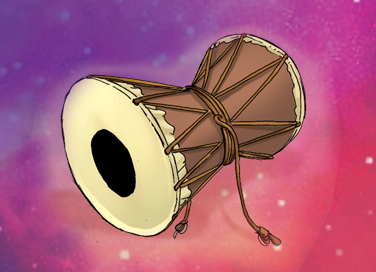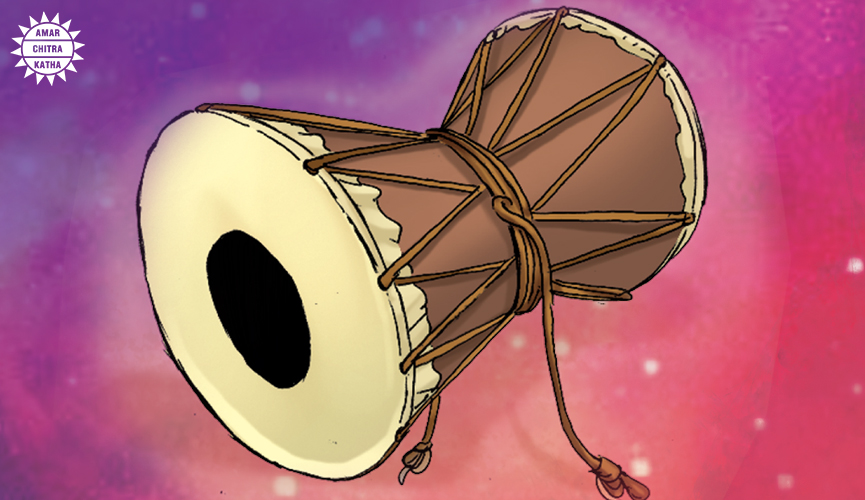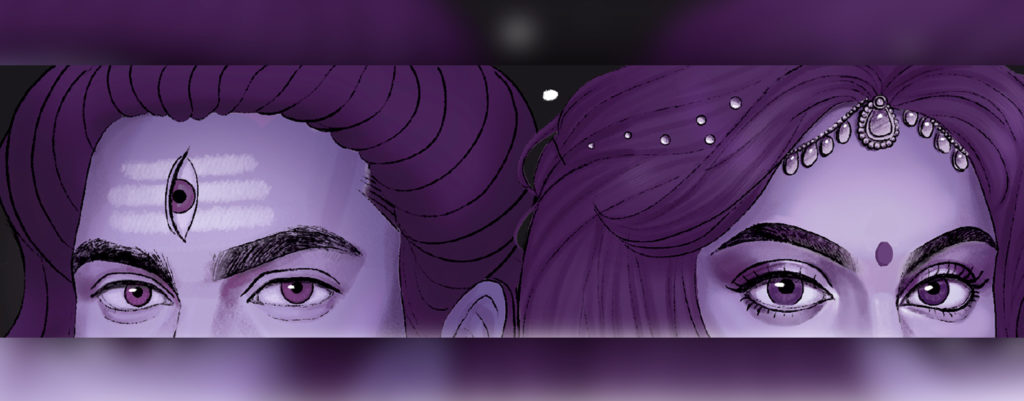The Damaru
- November 17, 2021


The Damaru
- November 17, 2021
By Kayva Gokhale
The Damaru plays an important role in the Puranas and is one of the main markers in Shiva’s iconography.

A Damaru is a small, hourglass-shaped drum that is most commonly associated with Lord Shiva in Hindu mythology. While it is unclear as to when exactly the Damaru originated, some sculptures of Shiva holding this drum have been dated back to the 10th century C.E. The Damaru also makes an appearance in the Tibetan practice of Tantric Buddhism after that.
To receive more such stories in your Inbox & WhatsApp, Please share your Email and Mobile number.
This hourglass-shaped drum is generally carved from a solid block of wood with skinheads covering each opening. A piece of string with pellets at each end (or a leather cord with knotted ends) is tied to the waist of the Damaru. The player holds the waist of the Damaru in their hand and rotates their wrist to make the ends of the string hit the skinheads, thus producing a reverberating sound.
There have been various philosophical and spiritual interpretations of the Damaru in Hinduism. According to the most common interpretation, the Damaru is seen as a representation of yin and yang, since the shape of the Damaru symbolises the coming together of male and female procreative energies, with the top portion representing the lingam and the bottom portion representing the yoni.

Apart from that, the Damaru has been seen as a representation of the rhythm of the heartbeat. The alternately rising and falling sound of the Damaru is seen as mimicking the human heart, thus symbolising the energy and sound of life itself. On a larger level, the Damaru also represents the rhythm of the entire universe. According to Hindu beliefs, the universe is constantly being created, preserved and destroyed, and has a cyclical nature. The beats of the Damaru thus symbolise the continuous expansion and collapse of the universe.
While the interpretations of the Damaru are abundant, it is also the central aspect of several fascinating legends and folktales. One of the legends associated with the Damaru calls it crucial to the creation of the universe. It is said that before creation, when there was simply a void, the Damaru gave rise to the first nada or sound. Shiva then performed the Tandava to the beats of the Damaru, thus creating the universe.
Some other legends state that the Damaru is responsible for the creation of all music. According to these stories, the sound of the Damaru was passed on to Shiva’s son, Ganesha, who is known to be a proficient player of the Pakhawaj. Ganesha then added more rhythm and sound to the Damaru beats and that’s how music was born.
According to yet another story, the Damaru was the source of grammar and music in the universe. It is believed that when the universe was created, Saraswati’s veena produced the first nada i.e. sound. At that time, Shiva played his Damaru fourteen times and this gave birth to grammar and music.
There is one more story that links the Damaru to the creation of the rules of grammar. According to this legend, Panini, the Sanskrit grammarian, was a great devotee of Shiva in his youth. Wanting to be blessed with divine knowledge from Shiva, Panini began his penance. It is said that he was so deep into his meditation that he did not break his trance even when Shiva appeared before him. In order to get Panini’s attention, Shiva began to play his Damaru. The sound of the Damaru jolted Panini out of his trance, after which Panini bowed to the Lord and received his blessing. The sound of the Damaru however, was so powerful that it continued to resonate in Panini’s ears even after Shiva disappeared. Panini is then believed to have formulated the rules of Sanskrit grammar, syntax and morphology in fourteen verses all due to the Damaru’s sound. Panini’s work is known as the Maheshwara Sutrani today and is one of the most significant texts on linguistics.
Apart from these legends explaining the role and significance of the Damaru, there is an interesting folktale involving the Damaru which highlights the importance of practice in one’s life. According to this tale, a village of farmers once offended Lord Indra, thus leading him to announce that the village would not receive rain for the next fourteen years. Upon hearing the pleas of the farmers of the village, Indra then amended his statement and declared that the village would receive rain only when Shiva played his Damaru. However, still wanting to teach the villagers a lesson, Indra went to Shiva and appealed to him not to play the Damaru for the next fourteen years – a request Shiva accepted immediately. Seeing all of this play out, the farmers turned hopeless and stopped working on their fields. However, one farmer out of them all continued to plough the field and plant seeds. Upon being questioned by the others, the farmer explained to them all that he did not wish to forget his skills and thus would continue to practice farming for the next fourteen years despite the absence of rain. Upon witnessing the scene, Parvati, impressed by the farmer, decided to help the villagers. She went to Shiva and insinuated that he would forget how to play the Damaru if he did not practice for fourteen long years. Shiva, now worried about losing his art, immediately began to practice his Damaru, causing Indra to adhere to his promise and restore rains upon the village.
Read more such fascinating tales and legends on the ACK Comics app!
To receive more such stories in your Inbox & WhatsApp, Please share your Email and Mobile number.

Comic of The Month
The Naval Journey of India Book I
This book is the first of a three-book series that takes a deep and detailed look at India's Naval History and a deep insight into the lives of our men and women in white. But any series on the Indian Navy has to start at the very beginning - exploring India's celebrated maritime history. Join our little hero, Bharat, and his grandfather, Commodore Sagar, as they sail into the deep blue waters of time. Book I of The Naval Journey of India takes a sweeping look at India's maritime endeavours, how the seas impacted us over millennia and how the oceans made us who we are.